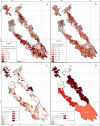Monitoring temporal changes in large urban street trees using remote sensing and deep learning
- PMID: 40570061
- PMCID: PMC12200653
- DOI: 10.1371/journal.pone.0326562
Monitoring temporal changes in large urban street trees using remote sensing and deep learning
Abstract
In the rapidly changing dynamics of urbanization, urban forests offer numerous benefits to city dwellers. However, the information available on these resources is often outdated or non-existent, leading in part to inequitable access to these benefits for the population. Access to equitable and just green spaces is a challenge for local governments, allowing the city's inhabitants to enjoy a healthy environment. In this context, remote sensing serves as a powerful data source that enables the monitoring of the evolution and dynamics of cities over time, as well as changes in urban forests. For this study, our focus is on large trees, defined as those with a canopy diameter exceeding seven meters. These trees play a vital role in offering ecosystem services that improve the environment, biodiversity, and mental health of the inhabitants of cities. Using deep learning algorithms, we identify the large urban street trees in National Agriculture Imagery Program (NAIP) images and analyze the changes in large street trees over an 18-year period (2005-2022) in six counties of the San Francisco Bay Area. We successfully tracked changes in the presence of large trees in the public right-of-way at the census tract, city, and county levels. We tracked changes in large tree availability at the neighborhood, city, and county levels, revealing socio-demographic disparities. Our analysis found that census tracts with higher household incomes, a greater proportion of individuals who self-identify as white, and more families were positively associated with an increase in large tree canopy. This assessment provides insight into the varying levels of access to ecosystem services offered by large trees across urban environments.
Copyright: This is an open access article, free of all copyright, and may be freely reproduced, distributed, transmitted, modified, built upon, or otherwise used by anyone for any lawful purpose. The work is made available under the Creative Commons CC0 public domain dedication.
Conflict of interest statement
No authors have competing interests.
Figures





Similar articles
-
A scoping review of tropical pioneer trees' roles for restoration and conservation management: Harungana madagascariensis (Hypericaceae) a widespread African species as a model.PeerJ. 2025 May 23;13:e19458. doi: 10.7717/peerj.19458. eCollection 2025. PeerJ. 2025. PMID: 40421372 Free PMC article.
-
Computer and mobile technology interventions for self-management in chronic obstructive pulmonary disease.Cochrane Database Syst Rev. 2017 May 23;5(5):CD011425. doi: 10.1002/14651858.CD011425.pub2. Cochrane Database Syst Rev. 2017. PMID: 28535331 Free PMC article.
-
Signs and symptoms to determine if a patient presenting in primary care or hospital outpatient settings has COVID-19.Cochrane Database Syst Rev. 2022 May 20;5(5):CD013665. doi: 10.1002/14651858.CD013665.pub3. Cochrane Database Syst Rev. 2022. PMID: 35593186 Free PMC article.
-
The health benefits of nature-based solutions to urbanization challenges for children and the elderly - A systematic review.Environ Res. 2017 Nov;159:362-373. doi: 10.1016/j.envres.2017.08.004. Epub 2017 Sep 18. Environ Res. 2017. PMID: 28843167
-
Systemic pharmacological treatments for chronic plaque psoriasis: a network meta-analysis.Cochrane Database Syst Rev. 2021 Apr 19;4(4):CD011535. doi: 10.1002/14651858.CD011535.pub4. Cochrane Database Syst Rev. 2021. Update in: Cochrane Database Syst Rev. 2022 May 23;5:CD011535. doi: 10.1002/14651858.CD011535.pub5. PMID: 33871055 Free PMC article. Updated.
References
-
- McPherson EG, Peper PP. Costs of street tree damage to infrastructure. Arboricultural Journal. 1996;20(2):143–60. doi: 10.1080/03071375.1996.9747110 - DOI
-
- Bigelow Jr LM, Fahey RT, Grabosky J, Hallett RA, Henning JG, Johnson ML. Predictors of street tree survival in Philadelphia: Tree traits, biophysical environment, and socioeconomic context. Urban Forestry & Urban Greening. 2024;94:128284.
-
- Nowak DJ. The interactions between urban forests and global climate change. Global climate change & the urban forest. 2000. p. 31–4.
-
- Hauer R, Peterson W. Municipal tree care and management in the United States. Population. 2015;25:10–000.
MeSH terms
LinkOut - more resources
Full Text Sources

